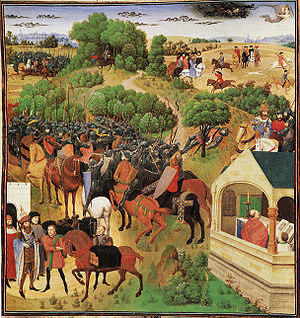Grandes Chroniques de France

Illumination of the Grandes Chroniques de France, copy of Philip the Good , mid-15th century.
The Grandes Chroniques de France were a work of medieval historiography , consisting of several independent chronicles supplemented by texts from other origins.
Originally it was a compilation of various texts on French history and monarchy , starting with the traditional Trojan roots, which were commissioned by Matthew of Vendôme († 1286 ), Abbot of Saint-Denis . The work soon had a symbolic significance as high as the restoration of the royal tombs in the abbey.
The monks of the abbey compiled the available sources:
- on the history of the Merovingians :
- the Gesta regum Francorum (or Historia Francorum ) by Aimoin von Fleury (around 970 – after 1008)
- the Gesta Dagoberti probably attributed to Hilduin von Saint-Denis (around 835), sometimes also Hinkmar von Reims (800 / 810–882)
- on the history of the Carolingians :
- the Annales Laureshamenses ( Lorscher Annalen )
- the Vita Caroli Magni (life of Charlemagne ) Einhard (around 770-840)
- the Vita Hludowici Imperatoris (Life of Emperor Ludwig ) by Astronomus
- such as:
- the Gesta normannorum ducum (Deeds of the Norman Dukes) by Wilhelm von Jumièges (2nd half of the 11th century )
- the Vita Ludovici VI (Life of Ludwig VI. ) by Suger von Saint-Denis (1081–1151)
- the Gesta Philippi Augusti (acts of Philipp August ) by Rigord (around 1160–1206) and Wilhelm the Breton (around 1160–1226)
From the sources, the Annals of Saint-Denis or Latin Chronicles of Saint-Denis (French Chroniques de Saint-Denis ) were compiled, which are now in the Bibliothèque nationale de France , and form the basis of the later Grandes Chroniques de France .
In the 1260s, the idea of writing a quasi-official historiography in French was born. A first attempt was made by a minstrel in the service of Alfonso of Poitiers (1220-1271), who translated the history of the kings of France , which had been written by 1214 with the help of various chronicles and the archives of the Abbey of Saint-Denis. Before this translation could prevail, in 1274, Matthew of Vendôme commissioned the monk Primat to translate the Latin Chronicles from 1250. This new text, a copy of which King Philip III. (1245–1285) (it is in the Sainte-Geneviève library ) was an instant success and encouraged sequels.
Wilhelm von Nangis († around 1300), who was in charge of the documents in Saint-Denis, added the reigns of King Louis the Holy (1214–1270) and Philip III to the Latin Chronicles , and then carried out the translation of his work into French himself . Several sequels appeared in Latin between 1285 and 1350, which were translated into French by other monks in several stages, which then became the continuation of the Grandes Chronique de France. Some loans were made by Richard Lescot , a monk in Saint-Denis, who wrote the continuation of the chronicle Géraud de Frachet (1205-1271) for the years 1328-1344 .
King Charles V (1338–1380) finally broke with the monastic tradition of this historiography when he gave the company a more official and also more political character. The monks continued work on the Latin Chronicles, of which the most famous and the closest (based on personal experience) to reality is the Chronique du Religieux de Saint-Denis , which covers the years 1380 to 1416. The author of this text is believed to be the Abbey's cantor , Michel Pinthouin .
Pierre d'Orgemont , Charles V's chancellor, himself edited the sections concerning his king, which turned the result into an apology for the monarch. For Charles VI. (1368–1422) a text by Jean Juvénal des Ursins (1388–1473) was adopted (up to 1402) , that is, the first part of a French abridged version of the Latin work of the monk of Saint-Denis, the Juvénal des Ursins, at the time he was an advocate at the Parlement in Poitiers around 1431 to highlight his family and his personal role. For the years 1403 to 1422 of the text by recording was Gilles Le Bouvier (1386-after 1454) Chronique de Héraut Berry completed
From 1422, official historiography returned to Saint-Denis in French. The monk Jean Chartier (around 1390–1464) was appointed the king's official historian in 1437, with the task of adding the reign of Charles VII (1403–1461) to the Grandes Chroniques de France . Its text, which breaks off in 1450, was published by the Paris bookstore Pasquier Bonhomme in 1476/77.
Among the many often illuminated manuscripts, the luxury copy that was made shortly before 1380 for Charles V and on which five Parisian illuminators, including the Maître aux Boqueteaux worked, stands out. This iconographic work was part of the representation on the occasion of Emperor Charles IV 's visit to Paris .
expenditure
- Grandes Chroniques de France , 15th century, new edition in 10 volumes, 1920–1953, Paris, Editions J. Viard
- Jean Fouquet . The pictures of the Grandes Chroniques de France. With the original reproduction of all 51 miniatures from Manuscrit français 6465 of the Bibliothèque nationale in Paris. Contributions by François Avril, Marie-Thérèse Gousset, Bernard Guenée, Graz 1987
literature
- Anne D. Hedeman: The Royal Image: Illustrations of the Grandes Chroniques de France, 1274-1422 . University of California Press, Berkeley 1991.
